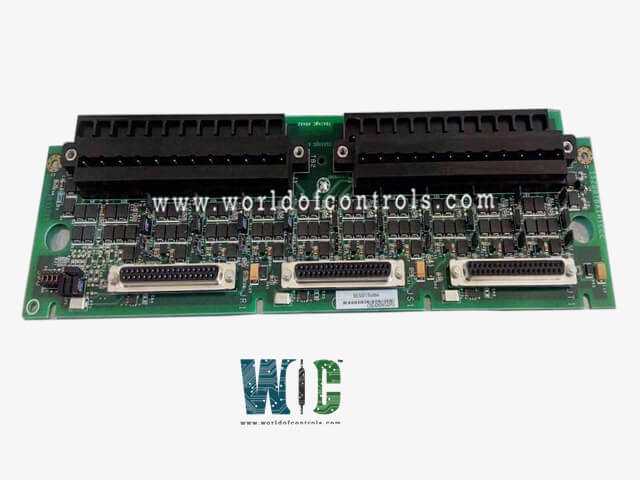
World Of Controls understands the criticality of your requirement and works towards reducing the lead time as much as possible.
IS200TBAIH2C - Analog Input/Output Terminal Board is available in stock which ships the same day.
IS200TBAIH2C - Analog Input/Output Terminal Board comes in UNUSED as well as REBUILT condition.
To avail our best deals for IS200TBAIH2C - Analog Input/Output Terminal Board, contact us and we will get back to you within 24 hours.
SPECIFICATIONS:
Part Number: IS200TBAIH2C
Manufacturer: General Electric
Series: Mark VIe
Function: Analog Input/Output Terminal Board
Number of Input Channels: 8 or 16
Input Signal Types: 4–20 mA
Number of Output Channels: 4
Output Signal Types: 4–20 mA
Operating Temperature: 0°C to 70°C
Number of Channels: 12
Communication Interface: D-type connector
Resolution: 16-bit DAC/ADC
Power Supply: 24 VDC nominal
Size: 10.16 cm wide x 33.02 cm
Repair: 3-5 Days
Availability: In Stock
Country of Manufacture: United States (USA)
Manual: GEH-6421M
FUNCTIONAL DESCRIPTION:
IS200TBAIH2C is an Analog Input/Output Terminal Board manufactured and designed by General Electric as part of the Mark VIe Series used in GE Distributed Gas Turbine Control Systems. The Analog Input terminal board supports 10 analog inputs and two outputs. The 10 analog inputs accommodate two-wire, three-wire, four-wire, or externally powered transmitters. The analog outputs can be set up for 0-20 mA or 0-200 mA current. Inputs and outputs have noise suppression circuitry to protect against surges and high-frequency noise. There are three DC-37 pin connectors provided on TBAI for connection to the I/O processors. Connections may be simplex on a single connector (JR1), or TMR using all three connectors. Connections may be through cables or directly to the electronics. In TMR applications, the input signals are fanned to the three connectors for the R, S, and T controls. TMR outputs operate by combining the currents of the three connected output drivers and determining the total current with a measuring shunt on the TBAI. The TBAI then presents the total current signal to the electronics for regulation to the commanded setpoint.
INSTALLATION:
The 10 inputs and two outputs are wired directly to two I/O terminal blocks mounted on the terminal board. Each block is held down with two screws and has 24 terminals accepting up to #12 AWG wires. A shield terminal attachment point is located adjacent to each terminal block. The types of analog inputs and outputs that can be accommodated are as follows:
OPERATION:
A 24 V dc power source is available on the terminal board for all the transducers. There is a choice of current or voltage inputs using jumpers. One of the two analog output circuits is 4-20 mA, and the other can be jumper-configured for 4-20 mA or 0- 200 mA. The same terminal board can be used for TMR applications. Transmitters/transducers can be powered by the 24 V dc source in the control system, or can be independently powered. Terminal board jumpers J#A, J#B, and JO set up the type of voltage and current inputs, and select the type of current output. Each output is monitored by diagnostics, and a suicide relay in the I/O controller disconnects the corresponding output if a fault cannot be cleared by a command from the processor.
WOC maintains the largest inventory of OEM replacement parts for GE Distributed Control Systems (DCS), including new, unused, rebuilt, and fully tested boards, all backed by a comprehensive warranty. We also offer expert repair and refurbishment services for faulty boards, ensuring reliable performance and minimal downtime. Our team of highly trained engineers is available 24/7 to provide technical support, troubleshooting, and guidance for all your automation and control system needs. For pricing, availability, or service inquiries, contact us by phone or email, and our experts will assist you in keeping your systems running smoothly and efficiently.
What is an Analog Input/Output Terminal Board?
An Analog Input/Output Terminal Board is a hardware component used in electronic systems to facilitate the conversion of analog signals between digital devices and physical quantities such as voltage, current, temperature, etc. It typically consists of multiple input and output channels for interfacing with sensors, actuators, and other analog devices.
How is an Analog Input/Output Terminal Board different from a Digital Input/Output Terminal Board?
An Analog Input/Output Terminal Board deals with continuous signals that vary in magnitude, such as voltage or current, whereas a Digital Input/Output Terminal Board handles discrete signals that are either ON or OFF, such as binary data. Analog boards are used when precise measurement and control of continuous variables are required, while digital boards are suitable for tasks where discrete control or communication is sufficient.
Can I use Analog Input/Output Terminal Boards with microcontrollers or single-board computers?
Yes, many Analog Input/Output Terminal Boards are compatible with microcontrollers, single-board computers (SBCs), and other embedded systems. They often interface via standard communication protocols such as USB, Ethernet, SPI, I2C, or analog interfaces like voltage or current signals.